Tale of Two (or more) Cities
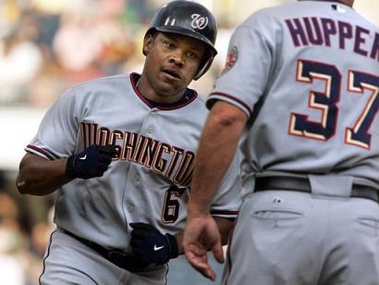 Washington Nationals' Jose Guillen rounds third base and is greeted by coach Dave Huppert after hitting a solo home run during the first inning off Pittsburgh Pirates starter Mark Redman Monday, June 20, 2005, in Pittsburgh. (AP Photo/Gene J. Puskar)
Washington Nationals' Jose Guillen rounds third base and is greeted by coach Dave Huppert after hitting a solo home run during the first inning off Pittsburgh Pirates starter Mark Redman Monday, June 20, 2005, in Pittsburgh. (AP Photo/Gene J. Puskar)Last Saturday's Boston Globe has an article "Faithful to Fenway" about how the Boston Red Sox committed to preserve the 93-year-old baseball park, and to help revitalize the Kenmore Square neighborhood of Baltimore.
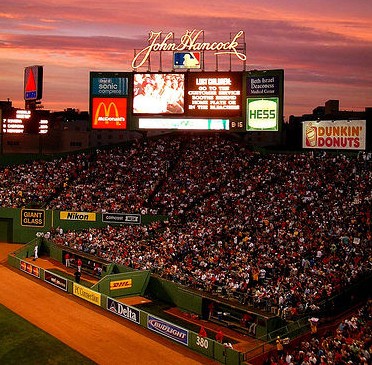 Fenway Park at Sunset. Photo from Flickr.
Fenway Park at Sunset. Photo from Flickr.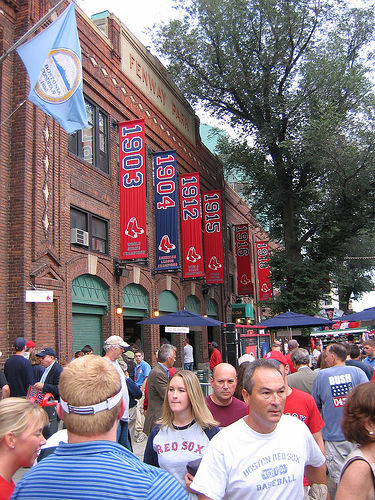 Yawkey Way, Fenway Park. Photo by PKeleher.
Yawkey Way, Fenway Park. Photo by PKeleher.Sunday's New York Times has an article on Tiger Stadium in Detroit, entitled "Once a Baseball Cathedral, Now Neglected and Decrepit," published in advance of tonight's All-Star Game. This article details how the stadium was abandoned in favor of a new stadium located just off Woodward Avenue in Downtown Detroit.
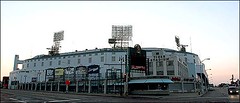 Tiger Stadium, photo from the New York Times.
Tiger Stadium, photo from the New York Times. Forlorn will call window, New York Times photo.
Forlorn will call window, New York Times photo.In a blog entry on Wednesday, February 23, 2005 (in the archive) entitled "Baseball, Hot Dogs, Apple Pie and Business as Usual," I wrote about the work of architect and professor Philip Bess. Clearly there is something to be said for the Boston approach. And it's worth repeating what I wrote back then...
___________
The Sunday February 6th Post has this article, "DC Seeks Signature Ballbark" , which says "But don't expect a throwback stadium such as Baltimore's Oriole Park at Camden Yards, which started a ballpark building boom in 1992, with its red-brick facade, ornate ironwork and historic warehouse. 'We do not want to see just another baseball stadium,' said Allen Y. Lew, chief executive of the D.C. Sports and Entertainment Commission. 'We want signature architecture. We're not looking to just mimic other cities.'"
All too often, "signature architecture" means "modernism" and too often, modernism is about architecture as art rather than as connection and making places that we can be proud of and even love. But it gets worse.
Today's Post has two articles about the stadium. The first, "8 Bid to Design Nationals' Stadium: Architects to Oversee Timetable and Budget for Construction" has this line within the article... "Major League Baseball, which owns the Nationals, wants a facility designed to draw large crowds and to offer attractions that encourage them to spend money inside the ballpark."
This is a major "economic development" issue with MCI Center. The arena's owners schedule events at times so soon after work that people go directly to the arena, and eat and spend the bulk of their money inside. The multiplier effect of economic benefits for area businesses end up not being that significant and anyway, is having chain restaurants like Hooters, Coyote Ugly, and Ruby Tuesday that big a win for the city?
Philip Bess, an architecture professor at Notre Dame, is the author of City Baseball Magic--Plain Talk and Uncommon Sense about Cities and Baseball Parks. His work makes the point that today's baseball stadiums, are outrageously expensive and provide neither intimacy nor a sense of community comparable to the classic neighborhood ballparks (like old Memorial Stadium). Retro or not, today's stadiums are conceived as suburban buildings.
They are a drain on taxpayers, they yield seating arrangements that are worse for the average fan in the upper deck, have high ticket prices, and they tend to destroy the physical and spatial fabric of cities. But most of these liabilities can be ameliorated by once again understanding the baseball park as an urban building subject to the physical constraints of urban networks of streets and blocks.
Clearly, urban city-oriented design isn't in the program for DC, if this line from an article about eminent domain and the Supreme Court--"Herb Miller, a major retail developer in the city who has submitted a plan to use private financing to pay for the stadium and build big-box stores on land around the stadium..."-- represents the prevailing attitude about baseball as the driver of "economic development" and "revitalization of the Anacostia Waterfront.
EIGHT IMPERATIVES FOR TRADITIONAL NEIGHBORHOOD BASEBALL PARKS
■ Think always of ballpark design in the context of urban design;
■ Think always in terms of neighborhood rather than zone or district;
■ Let site more than program drive the ballpark design---not exclusively, but more…;
■ Treat the ballpark as a civic building;
■ Make cars adapt to the culture and physical form of the neighborhood instead of the neighborhood adapting to the cars;
■ Maximize the use of pre-existing on- and off-street parking, and distribute rather than concentrate any new required parking;
■ Create development opportunities for a variety of activities in the vicinity of the ballpark, including housing and shopping;
■ Locate non-ballpark specific program functions in buildings located adjacent to rather than within the ballpark itself.
In closing he tells us that "it is possible to make new ballparks that are neighborhood friendly and generate equivalent revenues as current industry standard stadia, for about 2/3 the cost...."
________
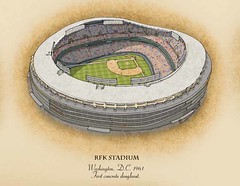 From the "Evolution of Balpark" poster.
From the "Evolution of Balpark" poster.Wonder what's gonna happen to RFK Stadium--not that it did much for "economic development" of the surrounding area... urban renewal from 1961.
See this online discussion with Post Sports Columnist Tom Boswell for more on the RFK Experience.



0 Comments:
Post a Comment
<< Home